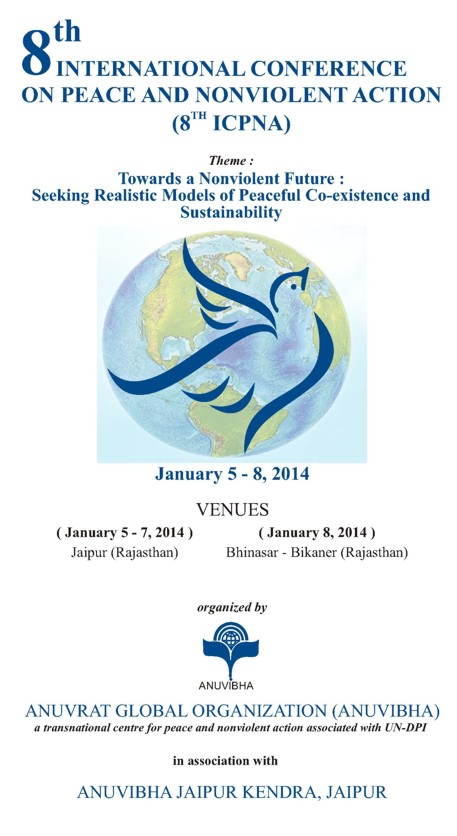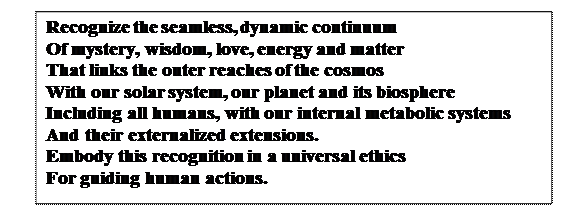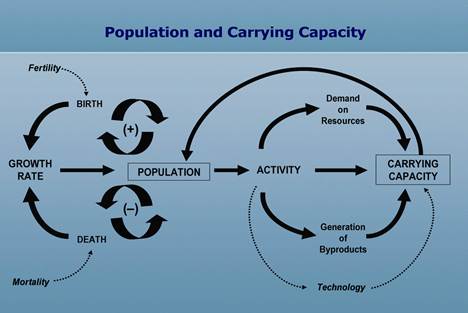 | 8th International Conference on Peace and Nonviolent Action |
Sustainability and Peace
Dear friends, thank you very much for the opportunity to join with you and share some thoughts concerning sustainability, an important topic that is critical to the well - being of our planet and the very future of humankind. Thank you, too, to the organizers for putting together this urgent event and making my participation possible, and thank you, in particular, to Dr. Sohan Lal Gandhi, whose tireless work on behalf of the Anuvrat Movement and world peace, I have been admiring for some time.
It is of great significance that in its central theme, this conference links peaceful coexistence and sustainability. The two are inexorably related. They are two sides of one coin and the pathological condition defined by the absence of both can be traced to the same root causes: individual and collective alienation and fear, on one hand, and greed on the other. The very same causes that drive violence towards other human beings extend to doing violence to the planet.
Peace and sustainability are conditions desired by most and yet, though actually very simple ideas, they are often clouded by ambiguity, misunderstanding and deep paradox. This is manifest, for example, when we hear leaders proclaim that in order to have peace we need to prepare for war, as it is by announcing a commitment to sustainable development while discussing it in terms of conventional, linear, perpetual economic growth.
The concept of sustainability, in particular, is not always well understood. The term itself, a relatively new addition to our vocabulary, has been watered down by broad - based use to the point that it lost its essence and more significant meaning. It is now used as a fashionable adjective with respect to almost anything. While usually grammatically correct - implying a notion of continuity - too often, the use of the term loses the deeper significance and broader context of our whole planet, the integrity and health of its biosphere, the future well-being of humanity and the factors which affect all of these.
Definition of Sustainability
The first thing one can say about the meaning of the concept of sustainability is that it pertains to a particular kind of dynamic equilibrium in the interaction of a population and the carrying capacity of its environment. This would be relevant to any population and any environment. It would hold true for amoeba in a Petri dish, elephants in their habitat, or humans on the planet. The underlying idea is crucial but too often overlooked, perhaps because both the related topics of population dynamics and of current patterns of consumption and waste require a commitment to practices, integrity and truth which prevailing conventions still prefer to ignore.
The type of equilibrium in question is characterized by a two - way circular structure, a loop, in which both sides of the equation - population and carrying capacity, in this case - affect one another in a continuous process of co-creation. The long history of the biosphere bears witness to this kind of evolutionary interaction, in which fundamentals of both sides continuously define and modify one another, producing, in the process, and with each step, the conditions and requirement for further evolution. Ecologies of all kind, it turns out, all display characteristics that are inherent to such circular interactions. All consist of networks of multiple variables, myriad multi-loops and multiple interdependencies, all co-accommodating to produce a state of dynamic equilibrium for the whole.
The simple two - way, interactive loop of population and carrying capacity masks an underlying complexity, a glimpse of which is suggested by the higher level of resolution depicted in the diagram below. Population is indicated on the left, and carrying capacity on the right. As suggested in the diagram, at any given time population level is determined by a net growth rate, which is driven, in turn, by the interaction of numerous other factors including birth rate, death rates, fertility, mortality, and other variables. The characteristics and specific composition of the environment and its carrying capacity exerts its own shaping influence as well.
A population impacts the carrying capacity of its environment through two main channels: the demands on resources and the generation of byproducts. Populations, in a sense, feed on their environment generating byproducts in the course of their activity which the environment needs to be able to absorb. The capacity of sources and sinks is therefore crucial. In the comprehensive context depicted here, sustainability represents a particular system’s state requiring that the rates of consumption and regeneration of resources, as well as the rates of discard and absorption of byproducts, are at equilibrium. This state of equilibrium, incidentally, is a dynamic condition reflecting a moving target that is defined and redefined by the particular circumstance of place and time.
Using the concepts of population and carrying capacity as the basis yields a rigorous definition of sustainability from which unambiguous policy and operational implications can be derived. Accordingly, I would like to offer you the following definition, which, you will note, captures in its logic the circularity of the underlying interaction.
Sustainability: A dynamic equilibrium in the processes of interaction between a population and the carrying capacity of its environment such that the population develops to express its full potential without producing irreversible adverse effects on the carrying capacity of the environment upon which it depends.
It is this equilibrium that is currently being compromised, with the unprecedented increase in the human population and the related intensification in human activities that are together overwhelming the capacity of the planet’s sources and sinks. The result is a system out of balance, with key components of the biosphere showing signs of alarming stress. The list is familiar. It includes ozone depletion, climate change, the loss of biodiversity, soil erosion and desertification, diminishing fresh water resources, shrinkage of forest cover, and the growing income disparity between and within nations. It also includes a persistent endemic failure of our social and economic institutions to address these issues effectively and in a timely manner.
Understanding the Challenge
The urgent sustainability related issues that we face on the planet today have still not captured center - stage in the attention of individuals, communities, governments, and enterprise. Awareness that “business cannot continue as usual,” is slowly growing, however, even among conservative institutions, and it is rapidly spreading among younger people everywhere who are genuinely concerned about the planet and the future.
The prevailing signs of stress are dismissed by some who maintain that these do not represent unusual or exceptionally alarming circumstances. Others conclude from studying the data of current trends that we are reaching absolute limits and that more than one planet will be required in order to provide for the projected growth in world population. I would like to suggest another perspective, which offers a radically different interpretation of our state of affairs. According to this interpretation, the evident signs of stress are the symptoms, the growing pains, in the process of humanity’s graduation to its next evolutionary step. These symptoms represent the results of tension between the prerogatives of beckoning new possibilities and the old ways of perceiving, organizing and doing things; the tension between a new reality struggling to be born and stubborn, conservative concepts and practices that are blocking its way.
One thing is clear: There is simply no precedence for managing the planet, with the projected soon - to - be - reached nine billion people on it, in harmony, dignified abundance, and peace. The required transformation calls for a complete reorientation of human affairs. A deep change in our worldview, in the values that guide our actions, in the structure of our economy, in the ways we use and allocate resources, in our priorities for the use of technology, in our modes of governance, and more. The need is for a second order change that will affect not only marginal aspects of our collective reality but that will fundamentally alter the underlying structure itself. Most existing tools, concepts, institutions, frameworks and mechanisms are not adequate to the task, having evolved in the past under a different context and entirely different circumstances. The planet as a whole, the concept of one humanity, and the objective of securing enduring sustainability for all defines our new context. Ultimately, the central objective of the required change is to foster a well-functioning alignment between individuals, society, the economy, and the regenerative capacity of the planet’s life - supporting ecosystems. The challenge now is for humanity to collectively step up to the task of shaping the next chapter in its own evolution - deliberately, wisely, and without fear.
The five core sustainability principles I developed as part of the work of The Sustainability Laboratory offer a potent guiding framework for the task.
The Five Core Principles
Returning to the diagram depicting the interaction between a population and the carrying capacity of its environment, it should be apparent that the key lines of interaction relate primarily to physical quantities - energy and matter - which characterize the channels of metabolic exchange. In the case of human communities, however, many non - physical factors combine to impact the ultimate outcome and shape the conditions upon which the desired state of sustainability depends. These include levels of awareness and consciousness, the prevailing view of the world, the accepted ways of doing things, and all the conventions, assumptions, frameworks, and values by which society organizes itself. As a working assumption, I find it convenient to group all the relevant factors in relation to a set of five major domains, each yielding one of the five core sustainability principles along with their derived policy and operational implications. The whole set is fundamentally systemic in nature as each domain affects all the others and is affected by each in return. The five domains include the following:
- The Material Domain, which constitutes the basis for regulating the flow of materials and energy which underlie existence.
- The Economic Domain,which provides the guiding framework for defining, creating, and managing wealth.
- The Domain of Life, whichprovides the basis for appropriate behavior in the biosphere.
- The Social Domain, which provides the basis for social interactions.
- The Spiritual Domain, provides the necessary attitudinal, value orientation, and acts as the basis for a universal code of ethics.
Let us briefly review each domain, along with its associated principle.
The Material Domain
The physical processes associated with this domain are subject to the general laws of physics, which prescribe the ultimate limits of possibilities in physical systems and, therefore, underlie the productive potential in the use of resources.
In this context, disciplined intelligence applied to designing universally advantageous configurations of energy and matter - arranging and rearranging components of the physical domain - can act as a potent anti-entropic function of order creation, with the enormous potential for providing the required infrastructure to support lasting abundance. Our industrial economy, by contrast, is wasteful and hugely entropic in nature. It ought to be reconfigured in order to secure a lasting advantage for all.
The First Principle
The Economic Domain
Economies consist of markets where transactions take place and guiding frameworks by which transactions are evaluated and decisions are made. The accounting framework presently used to guide our economy produces a grossly distorted view of the impacts of economic activity. It does not account for externalities such as the effects of depletion, pollution and waste, it is driven by a very narrow concept of growth, and it often allows the absurdity of counting consumption as though it were income.
The dominant conventions of our current accounting framework, including its inadequate measures, combine with systems of regulation and subsidies to drive markets in ways that exacerbate the adverse impacts of economic activity. A powerful self - reinforcing pattern is involved in the whole process, which clearly marks this domain as one requiring radical change.
The Second Principle
The Domain of Life
Human beings are one among thousands of species that make up the planet’s delicate fabric of life. We have not been very good neighbors. The adaptive success of our species comes at the expense of other forms of life, and the relentless destruction of individual organisms, species, habitats and whole ecosystems is reaching ominous proportions. This must be acknowledged as a major cause of alarm.
The important point is that the very complexity of complex systems is the source of their resilience and long - term viability. Self-organizing, living systems and their ecologies - rain forests, coral reefs and urban systems alike - depend, as science tells us, on inherent redundancy which allows for emergence and reemergence of different configurations in response to changing events. In contrast, monocultures can prove to be very brittle when their underlying circumstances change. And yet, we are actively reducing the richness of our planet’s complex fabric of life, at our own peril. In this regard, modern science joins ancient wisdom traditions in advocating sensitivity to the fundamental sacredness of all forms of life.
The Third Principle
The Social Domain
Early 20th century studies of cognitive processes and related questions of interactions of observers with their environment brought to the fore the fundamental fallibility of human knowledge, calling into question the notion of absolute truth. This suggests that in a true ecological fashion, myriad expressions and species of truth should be allowed to coexist without any particular one seeking to aggressively dominate others.
Arguments for encouraging plurality and maintaining diversity gain momentum when we consider that social systems, just like any ecology, depend on their internal variety for robust viability and long-term health. In addition, mapping of the human genome discloses no fundamental genetic differences between human groups, rendering arguments for an inherent superiority of any one group scientifically baseless.
All of this reinforce the still fragile idea that open processes, responsive structures, plurality of expression, and the inalienable equality of all individuals ought to provide the cornerstone of social life.
The Forth Principle
The Spiritual Domain
Although often busy trying to deny it, humans are essentially spiritual creatures. The human spirit has consistently sought to transcend apparent limitations. Its persistent drive to reach for a “beyond” - progressively including more into the field of vision and integrating an increasingly more comprehensive reality - is of enormous practical significance. The extent to which this drive is actually allowed to manifest affects the quality of our daily actions in the world.
The essence of the spiritual domain is not easy to pin down. The term is not used here to mean religion in the conventional sense of theology or dogma. Rather it is meant to evoke a sense of oneness, a deep underlying essence, a combination of inspiration, meaning, purpose, and a motivating all-embracing value. The inherent imprecision that is involved is reflected in the way the fifth principle is expressed.
The Fifth Principle

For each domain and for each principle, a number of policy and operational implications follow. Those define the pragmatic, necessary steps which, taken together, combine to outline and define the key elements in a comprehensive blueprint for change. We shall not be able to go over these in our allotted time this morning. Just to give you the flavor, however, they include such items like the requirement to strive for ever higher resource productivity; recycle minerals and metals and employ clean non-depleting energy sources such as water, solar and wind; reconfigure a wasteful industrial infrastructure such that byproducts of one process become the raw materials for another; align the world’s economy with nature’s regenerative capacity and incorporate critical externalities in cost and benefit accounts; assume a responsible stewardship of the planet’s biological diversity; enshrine universal human rights in the context of planetary citizenship and outlaw war and trade in weapon technologies; restore a sense of sanctity to our daily routines, and acknowledge the oneness, interdependent nature, and mystery of existence.
Even a casual review will suggest that every one of the five core principles and their derived operational implications is being ignored, or worse, violated, every day and everywhere. This is why our current path is not sustainable, why it must be changed. With a long evolutionary process behind it, civilization seems poised on the threshold of new possibilities. Humanity has an option to deliberately organize itself for a future of sane abundance and peace. Will it be wise enough to secure such a future? It could, by employing a higher, more inclusive level of consciousness and by addressing the challenge purposefully, decisively, collectively, and ethically.
The Five Principles as an Integrated Whole and the Spiritual Dimension of Sustainability
As I mentioned earlier, the set of five core principles is fundamentally systemic in nature. Elements making up each of the five domains inter - depend and affect one another, such that each domain affects all the others and is affected by each in return. This aspect has far reaching implications for crafting an effective strategy for change. It means that in seeking to establish the concept of sustainability as the organizing principle on the planet, piecemeal approaches - focusing on this or that aspect only - will not be enough. Disconnected, fragmented efforts, alone, will not yield effective, lasting results for the required transition to a globally sustainable state.
There are hundreds of excellent development projects implemented around the world, all of which attempt to internalize the sustainability agenda. Most, however, tend to be issue or sector specific. We see projects about energy, about water, about waste, about children, about community, but these - all welcomed initiatives - are rarely designed to affect the larger, whole system. Enacting a comprehensive sustainability agenda will require the simultaneous expression of all five core principles and the seamless integration of all five domains. Project Wadi Attir, for example, an initiative of The Sustainability Laboratory with a Bedouin community in the Negev desert - in which I am involved - deliberately designed to demonstrate the integrated application of the five domains and the five principles in one model microcosm.
A holistic, system perspective is key to our future and, as it turns out, the spiritual dimension, the spiritual principle, which is rarely incorporated as a driving element in the conventional calculus of practical affairs, is absolutely essential.
I have to tell you an anecdote about this. When I started to work on this framework, it did not take long to converge on the first four principles and I thought that the set was complete. After some time, I began to feel that something important was missing. I was struggling with this sense of incompleteness until I realized that what was left out was the spiritual aspect, an aspect that is so essential to the human experience. At the time, colleagues with whom I was sharing early drafts advised me to keep this element out. “If you want to be taken seriously by leaders of government and industry,” they would say, “you can not use the term spirituality in your work.” For a while, as a consequence, I would add it in or keep it out, depending on the audience, until I realized that the spiritual dimension is the lynchpin, the center of gravity which coheres everything else. The rest are basically techniques, while the spiritual domain is about the underlying purpose.
The simple fact is that without the spiritual, the value dimension, we are rudderless. This is the reason why the inspiring work of Acharya Shree Tulsi, whose centenary we are celebrating, is of such great importance to the world. The non - sectarian, universal outlook of the Anuvrat Movement, its spiritual code of conduct and associated practices are essential building blocks for laying the foundations of a sustainable world.
The formula and key elements for proper human conduct have been with us for thousands of years even when masked by the distracting veils of institutional dogmas. Now, science appears to confirm the wisdom of the spiritual quest. In their groundbreaking research on the neuroscience of enlightenment, M.D. David Perlmutter and his colleague Dr. Alberto Villoldo conclude that the quality of human behavior is directly related to which level in the nervous system dominates. They suggest that more enlightened behavior is associated with the higher centers of the cerebral cortex and the frontal lobe, both relatively recent products of evolution. What’s more, their research also indicates that the kind of exercises and spiritual practices developed by ancient shamanic and wisdom traditions, offer precisely the kind of tools required in order to train the nervous system and help produce wiser, more considerate, more peaceful, and more enlightened behavior. These results are very good news. They confirm the link between the spiritual and the practical, between our inner experience, and our behavior and its impact on the world. Moreover, they indicate that cultivating and realizing the highest qualities of the human potential is possible for every individual, showing the way to proactive improvement in conduct and, consequently, in the prospects for our species.
I would like to close by paraphrasing my own teacher and mentor, R. Buckminster Fuller, who encouraged us all to commit to the collective joint effort of “making the world work for all of humanity, in the shortest possible time, through spontaneous cooperation, and without ecological offense or the disadvantage of any one.”
Contemplate this phrase and you will find in it the essence of nonviolence.
Thank you.
 Dr. Michael Ben-Eli
Dr. Michael Ben-Eli




